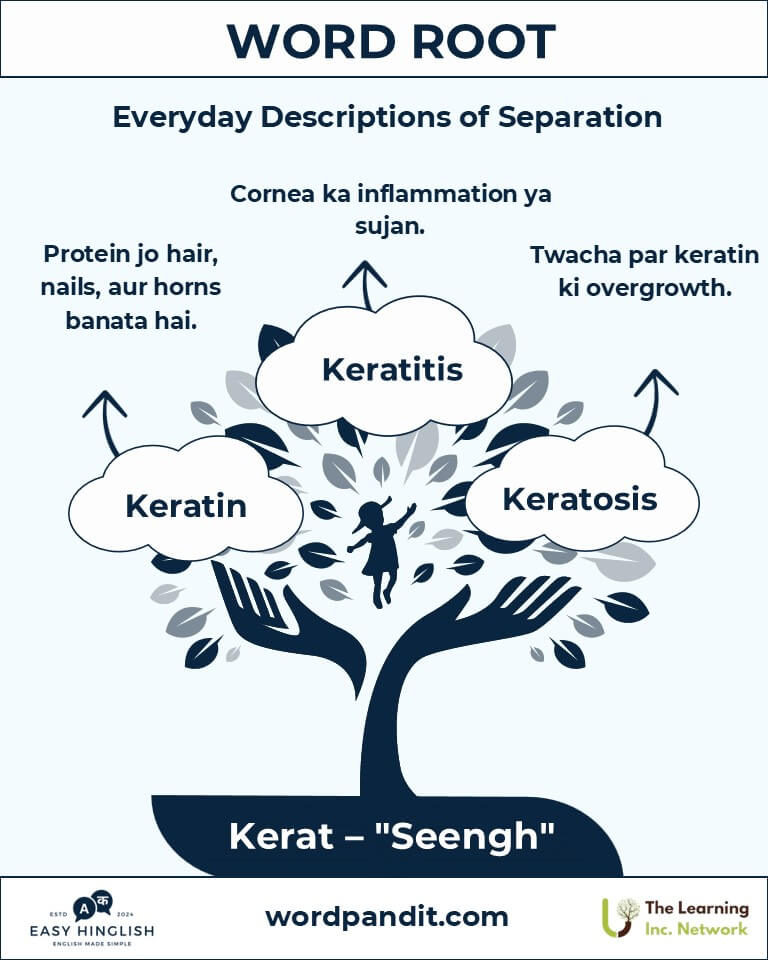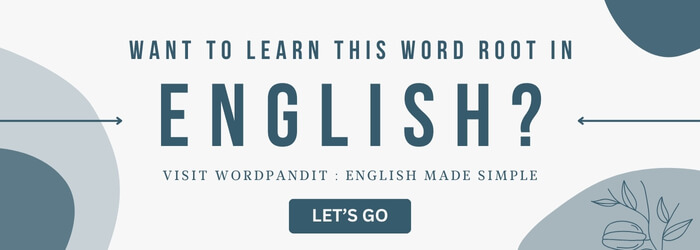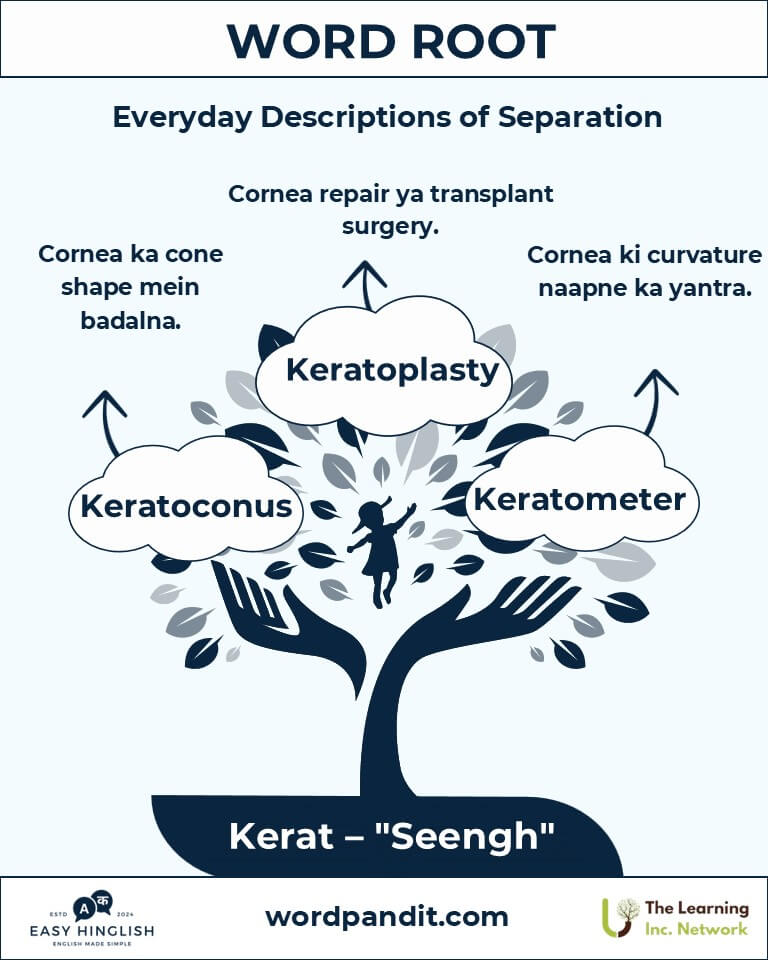Kerat: The Root of Horns and Resilience
Discover the fascinating role of the word root "Kerat," derived from Greek, meaning "horn." It is widely used in biological and medical vocabulary to describe structure, strength, and protection. Examples include keratin (a protein that forms our hair and nails) and keratitis (a condition affecting the cornea).

Table of Contents
- Introduction: The Essence of Kerat
- Etymology and Historical Journey
- Mnemonic: Unlocking the Power of Kerat
- Common Kerat-Related Terms
- Kerat Through Time
- Kerat in Specialized Fields
- Illustrative Story: Kerat in Action
- Cultural Significance of the Kerat Root
- The Kerat Family Tree
- FAQs About the Kerat Word Root
- Test Your Knowledge: Kerat Mastery Quiz
- Conclusion: The Enduring Legacy of Kerat
Introduction: The Essence of Kerat
Picture the strong horns of a ram or the protective layer of your nails. Both are products of keratin. Derived from the Greek word keratos, meaning "horn," this root represents resilience and protection. Pronounced "KEH-rat," it is widely used in biological and medical terminology.

Etymology and Historical Journey
The Greek word keratos means "horn." In ancient times, it was metaphorically associated with strength and durability. As science advanced, this root became central to describing structural proteins and body parts. Today, it is extensively used in dermatology and ophthalmology.
Mnemonic: Unlocking the Power of Kerat
Imagine a mighty ram standing on a rocky cliff, its horns gleaming in the sunlight—a perfect symbol of strength and protection.
Mnemonic Device: "Kerat keeps us strong, like a horn’s resilient song."
Common Kerat-Related Terms
- Keratin: A fibrous protein that forms hair, nails, and animal horns.
Example: "The hairstylist recommended a keratin treatment to strengthen my hair." - Keratitis (केरटाइटिस: Inflammation of the cornea due to infection or injury.
Example: "Her keratitis required immediate treatment to prevent further vision damage." - Keratosis(केरटोप्लास्टी: A skin condition where excessive keratin production leads to thick patches.
Example: "The dermatologist diagnosed the rough patch on his skin as keratosis." - Keratoplasty: A surgical procedure to repair or replace the cornea.
Example: "The patient underwent keratoplasty to restore her vision." - Keratoconus: A condition where the cornea thins and reshapes into a cone.
Example: "Keratoconus caused significant vision distortion, requiring specialized contact lenses."
Kerat Through Time
- Ancient Roots: Originally, "kerat" was used to denote horns and strength.
- Scientific Expansion: By the 19th century, it became part of dermatology and ophthalmology terminology.
- Modern Usage: Terms like keratoconus highlight its role in describing medical conditions.
Kerat in Specialized Fields
- Dermatology:
Keratosis: Conditions involving excessive keratin production.
Application: Used in diagnosing and treating skin disorders. - Ophthalmology:
Keratoplasty: A procedure to repair the cornea.
Application: Advances in eye care have made vision restoration more effective. - Zoology:
Keratin Structures: Found in horns, hooves, and feathers.
Application: Helps understand evolutionary biology.
Illustrative Story: Kerat in Action
Lila, a veterinarian, was treating a ram whose horns had cracked. She explained to the owner that the strength of horns comes from keratin and proper nutrition is essential. Later that day, at an ophthalmologist’s appointment, Lila learned she needed a minor keratoplasty. These two experiences highlighted the versatility of the root "kerat" in different fields.
Cultural Significance of the Kerat Root
Horns symbolize strength and protection in many cultures, which ties into the significance of keratin. From ancient myths to modern science, the role of "kerat" remains prominent.

The Kerat Family Tree
- Corne- (Latin: "horn")
Example: Cornea - The transparent front part of the eye. - Derm- (Greek: "skin")
Example: Dermatitis - Inflammation of the skin. - Scler- (Greek: "hard")
Example: Sclerosis - Hardening of tissues.

FAQs About the "Kerat" Root
Q: "Kerat" ka kya matlab hai aur iska "horn" se kya sambandh hai?
A: "Kerat" ka matlab hai "horn" (सींग), jo Greek word "keratos" se aaya hai. Iska sambandh strength aur protection se hai, jaise keratin jo hair, nails aur cornea ko mazboot banata hai.
Q: Keratin kya hai aur yeh kyun important hai?
A: Keratin ek fibrous protein hai jo strength aur resilience provide karta hai hair, nails, aur animal horns ko. Yeh inko physical damage se protect karta hai.
Q: Keratitis ka kya kaaran aur ilaj hai?
A: Keratitis, cornea ka inflammation hota hai jo infection (bacterial, viral, fungal), injury, ya dry eyes ki wajah se ho sakta hai. Ilaj mein antibiotics, antiviral drops ya severe cases mein surgery (keratoplasty) shamil hoti hai.
Q: Keratoplasty kya hai aur yeh kab kiya jata hai?
A: Keratoplasty ek surgical procedure hai jisme cornea ko repair ya replace kiya jata hai. Yeh severe damage, scarring, ya diseases (e.g., keratoconus) mein kiya jata hai.
Q: Keratosis aur keratitis mein kya antar hai?
A: Keratosis ek dermatological condition hai jo skin pe keratin ke overproduction ki wajah se patches banata hai, jabki keratitis ek ophthalmological condition hai jo cornea ko affect karta hai.
Test Your Knowledge: Kerat Mastery Quiz
1. "Kerat" ka kya matlab hai?
2. Keratitis kya hai?
3. Kaunsa term hair aur nails ke protein ko describe karta hai?
4. Keratoplasty kya hai?
5. Keratoconus kisko affect karta hai?
12. Conclusion: The Enduring Legacy of Kerat
(Kerat ki Jeevant Virasat - केरट की जीवंत विरासत)
"Kerat" resilience aur protection ka ek prateek hai. Yeh biological aur medical contexts mein ek significant role nibhata hai.








